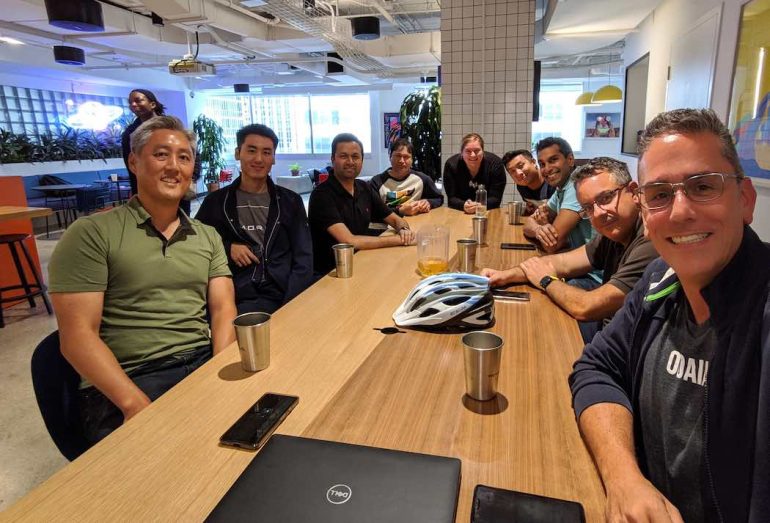AI-powered software-as-a-service (SaaS) startup ODAIA has raised $1.6 million in seed funding to help fuel its predictive customer analytics tool.
The round as co-led by StandUp Ventures and Panache Ventures, which earlier today announced the final close of its Fund I. ODAIA’s seed round also saw participation from BDC Capital’s Women in Technology Venture Fund, Inovia Capital, and MaRS IAF.
“Productizing AI as a SaaS platform is a challenging endeavor that very few companies have been able to deliver.”
Founded in 2018, ODAIA was spun out of the University of Toronto in October by professor Periklis Andritsos and adjunct professor Helen Kontozopoulos, as well as University of Lausanne PhD student Gael Bernard and current CEO Philip Poulidis.
ODAIA offers a data analytics, process mining and machine learning (ML) platform that analyzes customer touchpoints, to help companies better understand “customer journeys.” With the goal of helping companies “create efficiencies and grow revenues” around customer engagement, ODAIA hopes to become the AI platform for every customer touchpoint “across all parts of an organization.”
From academia to commercialization
The idea for ODAIA came out of years-long work done at the university level by Andritsos and Bernard. Kontozopoulos, who co-founded the University of Toronto’s department of computer science innovation lab accelerator, joined ODAIA in early 2018 in order find commercialization opportunities for the technology.
Poulidis explained that after incorporating the startup spent the first five months trying to prove the algorithms using real data sets from customers. After successful trials, and finding a market fit, ODAIA began developing its SaaS platform around its algorithms.
“Once we validated that with some customers we started to hire an engineering team with some pre-seed funding that came in from our angel investors,” Poulidis told BetaKit. “And things started moving very quickly. We started to take on more customers, the proof points were there, and we really needed to step up on developments.”
RELATED: April #FutureMakers on digital ethics shows need for better data and fewer silos
“We wanted to beef up our machine learning team and start to productizing the algorithms that we’ve proven out,” Poulidis added.
That was when ODAIA decided to raise a seed funding round. The startup plans to use a portion of the $1.6 million to help grow its team, which currently sits at nine employees. Poulidis noted, however, that the focus is on helping existing customers deploy ODAIA’s platform, with the goal of launching publicly in 2020.
“Productizing AI as a SaaS platform is a challenging endeavor that very few companies have been able to deliver,” said Prashant Matta, partner at Panache Ventures. “After meeting countless startups, ODAIA was the first we met where we felt confident in the team’s ability to pull it off.”
Doing things differently
In a public statement, ODAIA referenced Gartner statistics that predict the customer journey analytics market will grow from $4.76 billion USD in 2017 to $12.22 billion USD by 2022.
The startup noted that while there are existing platforms that offer enterprise data through visualization tools, data often tends to be “scattered across numerous information technology systems” with tools that “lack sophisticated methods” of AI and ML.
“What I’m seeing now, here is reminding me of what I used to see in Silicon Valley 10 to 15 years ago.”
“Enterprises need a system that can offer a complete picture of a customer’s behaviour, draw correlations between data sets, and capture multi-channel actions and contextual data, as well as offer accurate predictive models,” ODAIA stated.
One use case for ODAIA’s platform is a current IoT service provider customers that uses the technology to determine the level of engagement of its millions of subscribers, as well as the likelihood of customer attrition. Poulidis told BetaKit that ODAIA’s algorithms can predict who’s engaging or disengaging and predict well in advance the attrition rates in order to help companies take action ahead of time.
“ODAIA is adding a new dimension to customer journey analytics with a new tool that enables employees to work directly with customer journey data to help deliver better customer experiences,” said Michelle McBane, managing director at StandUp Ventures. “We saw a great opportunity to invest in a diverse team that we believe will grow to be leaders in their industry.”
The $1.6 million also includes pre-seed funding Toronto Innovation Acceleration Partners (formerly MaRS Innovation), University of Toronto’s UTEST, and N49P along with Amar Varma, the co-founder of Autonomic.ai, which was acquired by Ford.
RELATED: Daisy Intelligence raises $10 million CAD, looks to become “the world’s largest” AI company
Poulidis, formerly the senior vice president and GM of Blackberry, joined as ODAIA’s CEO in September. Prior to that Poulidis spent almost 10 years working in Silicon Valley and was drawn back to Canada after seeing a Go North advertisement while driving on an interstate highway in California.
“I decided to come back to Canada, primarily because of all of the ecosystem that has been built up here,” the CEO told BetaKit. “Over the last number of years, it’s been absolutely phenomenal. What I’m seeing now, here is reminding me of what I used to see in Silicon Valley 10 to 15 years ago.”
Poulidis added that ODAIA is set apart from, and gives it the advantage over, competitors and other AI companies in the space, is its algorithms, which are based on process mining techniques.
“Then we layer our own prediction algorithms on top of that, and what that does is it gives [ODAIA] the ability to explain the results,” Poulidis noted. “So unlike black box, deep learning, AI, [ODAIA’s] actually is explainable … it’s something that we actually can do because of the way that we implement our algorithms.”
Image courtesy ODAIA


